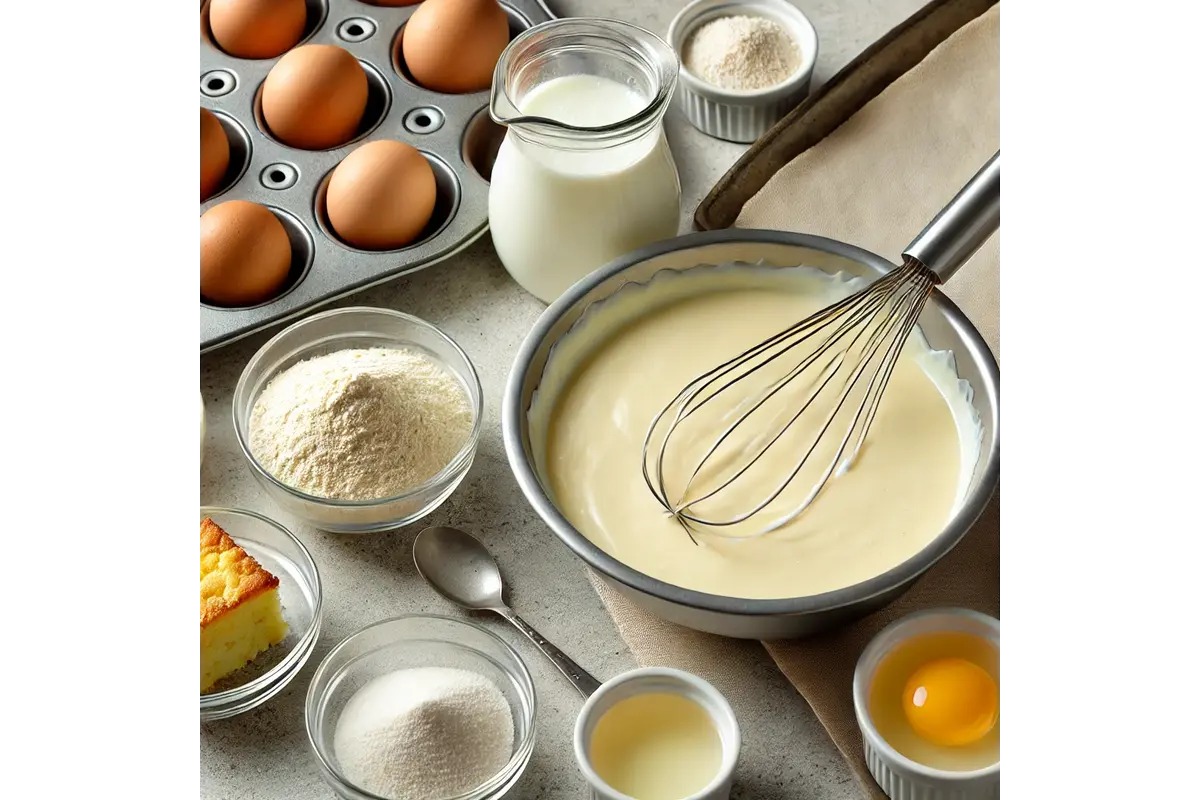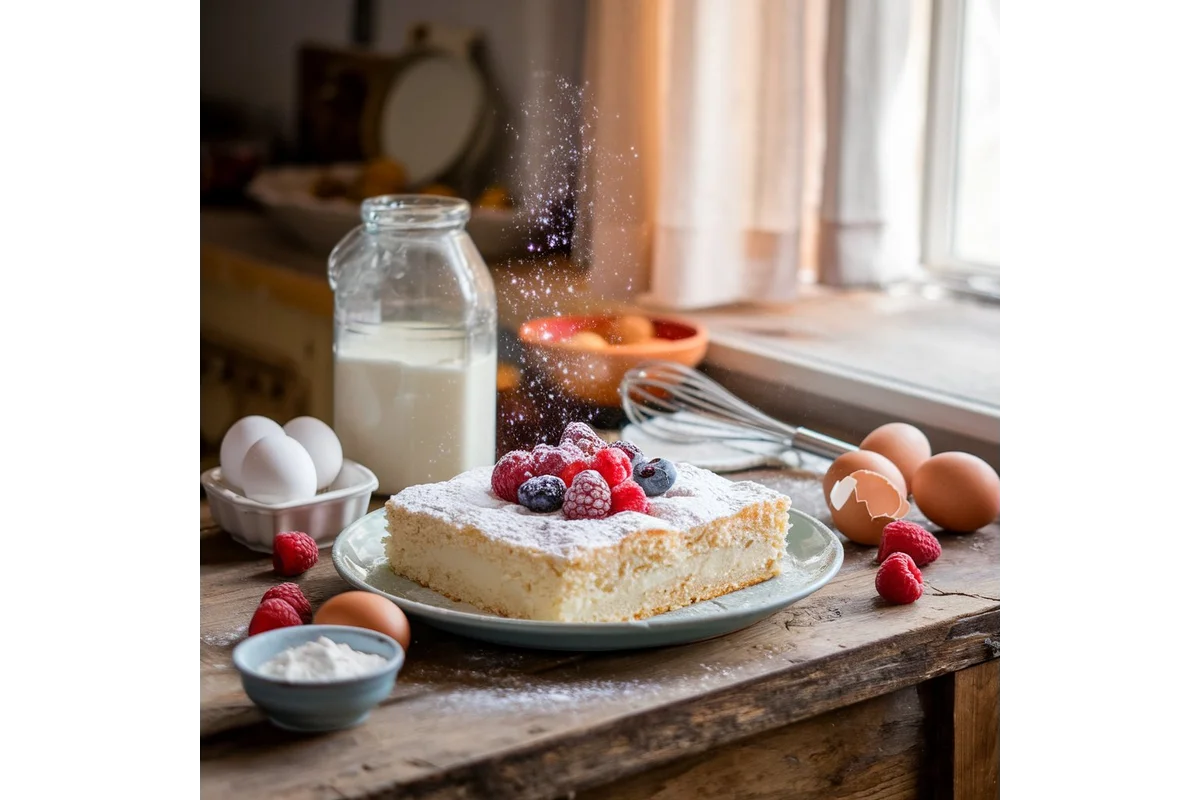If you’ve been searching for a dessert that combines simplicity with a tangy twist, look no further than the kefir sheet cake recipe. This moist and fluffy treat is a favorite for its unique use of kefir, a fermented milk product known for its probiotics and rich texture. The kefir sheet cake recipe card is the perfect tool to guide both beginners and seasoned bakers. It’s versatile enough to suit any occasion, from family gatherings to casual tea breaks.
What makes kefir so special in baking? It’s not just about flavor; kefir provides an unparalleled moistness that elevates your baking game. Learn more about the health benefits of kefir and its role as a nutritional powerhouse.
Table of Contents
Why Use Kefir in Baking?
The Science Behind Kefir
Kefir is not just another ingredient; it’s a key player in making cakes light, fluffy, and flavorful. To start, kefir has a mild acidity, which works wonders in baking. When mixed with baking soda, it creates a reaction that releases carbon dioxide bubbles. These bubbles are what make your cake rise beautifully and give it that soft, airy texture.
But that’s not all. Kefir also plays a role in breaking down the batter’s starches and sugars, making them easier to mix and bake evenly. Its unique tangy flavor adds just the right amount of complexity to balance the sweetness of a cake. This means your cake doesn’t just taste sugary—it has layers of flavor.
Why Kefir is Good for Baking
Kefir does more than just help with rising. Its creamy texture helps keep cakes moist and soft for longer. It’s also a natural tenderizer, meaning it prevents cakes from turning out too dense or tough. Plus, if you’re looking to make your desserts a bit healthier, kefir is a smart choice. You can often use it as a substitute for heavier ingredients like sour cream, reducing fat while keeping the same creamy goodness.
Other Perks of Using Kefir
- It’s packed with probiotics, which are good for digestion—even after baking.
- It enhances the cake’s structure, making it hold together better without being heavy.
- It’s versatile and works well with flavors like chocolate, vanilla, or lemon.
Ingredients for the Perfect Kefir Sheet Cake Recipe
Must-Have Ingredients for a Perfect Kefir Sheet Cake Recipe
Every great cake starts with the right ingredients. For a kefir sheet cake recipe card, these essentials ensure a moist, flavorful, and perfectly risen dessert.
Kefir
- Why it’s important: Kefir is the star of the show, offering both moisture and tanginess. Its acidity helps activate the baking soda, making the cake light and fluffy.
- Pro tip: Use fresh kefir for the best results. Homemade kefir can add a personal touch and allow you to control the tang level.
Flour
- Why it’s important: Flour provides the cake’s structure, giving it the strength to hold its shape while remaining soft and tender.
- Pro tip: Use unbleached all-purpose flour for a more natural flavor, or try cake flour for an even lighter crumb.
Sugar
- Why it’s important: Sugar balances the tanginess of the kefir and adds sweetness. It also helps the cake achieve a golden, caramelized crust.
- Pro tip: For a deeper flavor, substitute part of the sugar with brown sugar or coconut sugar.
Eggs
- Why they’re important: Eggs are the binders that hold everything together. They also add richness and contribute to the cake’s moist texture.
- Pro tip: Use room-temperature eggs for better mixing and more consistent baking.
Baking Soda
- Why it’s important: Baking soda reacts with the kefir to create carbon dioxide, which makes the cake rise and gives it its soft texture.
- Pro tip: Ensure your baking soda is fresh; an old batch might not react properly, leading to a dense cake.
Additional Ingredients to Enhance Your Cake
- Butter or Oil: Adds richness and helps keep the cake moist. Choose butter for flavor or oil for extra softness.
- Vanilla Extract: A dash of vanilla enhances the cake’s overall flavor profile.
- Optional Add-Ins: Add chocolate chips, nuts, or dried fruit to make the cake even more special.
Extra Tips for Ingredient Selection:
- Use whole-fat kefir: It’s richer and creamier, which means a more luscious cake.
- Consider alternative flours: For a healthier twist, try substituting part of the all-purpose flour with almond or oat flour.
- Check your measurements: Precise measurements are key to ensuring your cake turns out perfectly every time.
- Sift your dry ingredients: This prevents lumps and ensures an even distribution of baking soda and flour.
With these ingredients and tips, you’ll be well on your way to making a kefir sheet cake that’s not only delicious but also foolproof!
Step-by-Step Guide to a Delicious Kefir Sheet Cake Recipe

Ingredients
Here’s what you’ll need to get started:
- 1 cup of kefir: Provides moisture and tanginess, key to the cake’s soft texture.
- 2 large eggs: Essential for binding the batter and adding richness.
- 1 ¾ cups of all-purpose flour: The structure builder of your cake.
- ¾ cup of granulated sugar: Adds sweetness to balance the tang of kefir.
- ½ cup of melted butter (or oil): Keeps the cake moist and enhances flavor.
- 1 teaspoon of baking soda: Reacts with kefir to create a light, airy crumb.
- 1 teaspoon of vanilla extract: Adds a subtle, sweet aroma.
- ¼ teaspoon of salt: Balances and enhances all flavors.
Preparation
- Preheat your oven to 350°F (175°C) to ensure even baking.
- Grease and line a sheet pan with parchment paper to prevent sticking and make cleanup easier.
Mixing Ingredients
- In a mixing bowl, whisk together kefir and eggs until smooth. This step ensures the base of your batter is well-combined.
- Slowly add the sugar and vanilla extract, mixing until fully incorporated.
- In a separate bowl, sift together the flour, baking soda, and salt to remove any lumps and evenly distribute the leavening agent.
- Gradually add the dry ingredients to the wet mixture, stirring gently to avoid overmixing. Overmixing can lead to a dense cake.
- Fold in the melted butter or oil until the batter is smooth and glossy.
Baking
- Pour the prepared batter evenly into the greased and lined sheet pan.
- Gently tap the pan on the counter to remove any air bubbles.
- Bake for 25-30 minutes, or until a toothpick inserted into the center of the cake comes out clean.
- Allow the cake to cool completely in the pan before transferring to a serving plate or adding any frosting.
Variations of Kefir Sheet Cake Recipe
One of the best things about a kefir sheet cake recipe card is its versatility. With just a few tweaks, you can transform the classic cake into exciting new flavors that suit any occasion. Here are some delightful variations to try:
Chocolate Kefir Cake
- How to make it: Add ¼ cup of unsweetened cocoa powder to the dry ingredients for a rich, chocolaty twist. For even more indulgence, fold in ½ cup of chocolate chips or drizzle melted chocolate over the baked cake.
- Why it works: The tanginess of kefir enhances the depth of the chocolate flavor, creating a cake that is moist and decadent without being overly sweet.
- Pro tip: Pair it with a simple chocolate ganache or whipped cream frosting for the ultimate dessert.
Lemon Kefir Cake
- How to make it: Add 1 tablespoon of lemon zest and 2 tablespoons of freshly squeezed lemon juice to the wet ingredients. For an extra punch of flavor, mix a lemon glaze with powdered sugar and lemon juice to drizzle on top.
- Why it works: The acidity of the lemon complements the tang of the kefir, creating a bright and zesty flavor profile.
- Pro tip: Garnish with candied lemon slices or a sprinkle of powdered sugar for a beautiful finish.
Gluten-Free Kefir Cake
- How to make it: Replace the all-purpose flour with almond flour, oat flour, or a store-bought gluten-free baking mix. Ensure that your other ingredients, like baking soda and vanilla extract, are also gluten-free.
- Why it works: Kefir’s moisture content helps prevent the common dryness associated with gluten-free baking, resulting in a tender and flavorful cake.
- Pro tip: Add a pinch of xanthan gum if your gluten-free flour mix doesn’t already include it to improve the cake’s structure.
Other Fermented Dessert Inspirations
If you’re looking for even more creative ways to incorporate fermented ingredients into desserts, consider trying recipes like Brookies. These innovative combinations highlight how versatile and exciting baking with fermentation can be. From tangy twists to moist textures, fermented desserts bring something truly special to the table.
With these variations, your kefir sheet cake recipe card becomes more than just a guide—it’s a foundation for culinary creativity. Whether you’re a chocolate lover, a citrus enthusiast, or gluten-free, there’s a version here for everyone. Enjoy experimenting with these ideas to make your cake uniquely yours!
Creative Toppings and Frostings
Whipped Cream and Fresh Fruits
- Why it works: A dollop of fluffy whipped cream paired with fresh fruits like strawberries, blueberries, or raspberries adds a light, refreshing element. The natural sweetness of the fruits complements the tangy kefir beautifully.
- Pro tip: For an elegant touch, lightly glaze the fruits with honey or a simple syrup.
Chocolate Ganache
- Why it works: Made from melted chocolate and heavy cream, ganache adds a rich, glossy finish that’s perfect for chocolate lovers. Its decadent texture contrasts wonderfully with the lightness of the cake.
- Pro tip: Add a sprinkle of sea salt to the ganache for a sophisticated sweet-and-salty flavor.
Nut and Caramel Drizzle
- Why it works: The crunch of toasted nuts like pecans, walnuts, or almonds, paired with the smooth sweetness of caramel, creates a luxurious topping. The flavors add depth and texture to the cake.
- Pro tip: Use a salted caramel sauce for an extra flavor boost, and sprinkle a pinch of cinnamon over the nuts for a warm, aromatic twist.
Cream Cheese Frosting
- Why it works: The tang of cream cheese mirrors the kefir’s tanginess, creating a harmonious balance. It’s rich, smooth, and perfect for spreading over the cake in a thick layer.
- Pro tip: Add a splash of vanilla extract or a dash of lemon juice to enhance the frosting’s flavor.
Coconut Glaze
- Why it works: A simple glaze made from powdered sugar and coconut milk adds a tropical flair. Sprinkle shredded coconut on top for added texture and a hint of sweetness.
- Pro tip: Toast the coconut for a nutty, caramelized flavor.
Powdered Sugar and Edible Flowers
- Why it works: Sometimes, less is more. A light dusting of powdered sugar gives the cake an understated elegance, while edible flowers make it visually stunning.
- Pro tip: Choose flowers like pansies, violas, or rose petals for a pop of color and a subtle floral note.
From traditional buttercream to adventurous flavors, the possibilities are endless. With these toppings and frostings, you can customize your kefir sheet cake to suit any occasion or flavor preference. Whether you prefer something light and fruity or rich and indulgent, there’s a perfect topping to match your style!
Common Mistakes and How to Avoid Them
- Overmixing Batter: Leads to dense cake.
- Underbaking: Always check with a toothpick.
- Improper Storage: Keep it airtight to retain freshness.
FAQs About Kefir Sheet Cake
Q: Can I substitute kefir with buttermilk or yogurt?
A: Yes, buttermilk or plain yogurt can work as substitutes in a pinch.
Q: How long does it stay fresh?
A: Stored properly, a kefir sheet cake can last up to 5 days in the refrigerator.
Q: Can it be frozen?
A: Absolutely! Wrap tightly in plastic wrap and freeze for up to 3 months.
Conclusion
Creating a kefir sheet cake recipe card isn’t just about baking; it’s about connecting with a tradition that marries flavor, texture, and health benefits into a single delicious bite. The versatility of this cake allows it to shine as a centerpiece at gatherings, a comforting treat during quiet moments, or even as a thoughtful homemade gift.
What sets the kefir sheet cake apart is how easily it adapts to different tastes and occasions. Whether you choose the simplicity of a classic version, the richness of chocolate, or the zestiness of lemon, this cake always delivers. Its soft crumb, moist texture, and balanced flavor profile make it a crowd-pleaser that even novice bakers can master.
Moreover, incorporating kefir into your baking is a wonderful way to boost your health. Packed with probiotics, kefir contributes to better digestion, making your indulgence a bit more guilt-free. This cake isn’t just a dessert—it’s a wholesome experience that combines nourishment and enjoyment.

